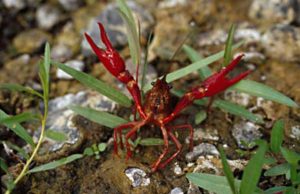Red Swamp Crayfish (Procambarus Clarki)

Have you seen this creature in your local streams and ponds? The red swamp crayfish (Procambarus clarki) is a predator and scavenger with potentially devastating impacts on native amphibian, fish, and invertebrate populations. Like many introduced animals, the red swamp crayfish has no local predators to keep them in check, allowing them to proliferate. Recent studies conducted in the Santa Monica Mountains have linked crayfish to the decline of some of our local amphibians such as the California coastal range newt.
Once introduced into our aquatic habitats, red swamp crayfish are very difficult to eradicate. Crayfish are able to burrow down three feet into the mud when water levels are low and are capable of moving on land to find nearby pools. Crayfish are excellent parents, caring for the eggs and young until they have grown to a sufficient size to venture out on their own. It takes less than one year for a crayfish to reach full reproductive maturity.
How do these lobster-like creatures make it into our lakes and streams? Unfortunately, we introduce them. Crayfish are popular bait for bass fishermen. They are sold in many fish and tackle shops and are stocked in local lakes as a food source for game fish like large mouth bass and bluegill. However, the problem is not just the local fisherman. The way we live also provides habitat for these creatures. A naturally dry creek is not ideal habitat for a crayfish. By over-watering our lawns and hosing down our streets, we provide the excess flows that crayfish need to survive. Do you have water flowing through your nearby creeks? If you do, crayfish may already be there. Crayfish can be so prolific that you may find fifty of them sitting at the bottom of a deep pool.
The invasive crayfish is just one example of our potential impact on local creeks and streams. Introducing anything into an environment that does not belong there, including pet goldfish and turtles, excess water, pesticides and fertilizers, effects the local plant and animal species that live there.
